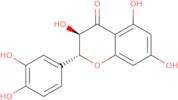
(+/-)-Taxifolin
CAS: 24198-97-8
Ref. 3D-FT28010
| 1g | 705,00 € | ||
| 2g | 1.071,00 € | ||
| 5g | 1.607,00 € | ||
| 250mg | 300,00 € | ||
| 500mg | 443,00 € |
Información del producto
- Dihydroquercetin3,3',4',5,7-Pentahydroxyflavanone hydrate
- (?à)-Dihydroquercetin
- (?à)-Taxifolin
- (±)-Dihydroquercetin
- (±)-Taxifolin
- 4H-1-Benzopyran-4-one, 2-(3,4-dihydroxyphenyl)-2,3-dihydro-3,5,7-trihydroxy-, trans-(±)-
- 4H-1-Benzopyran-4-one,2-(3,4-dihydroxyphenyl)-2,3-dihydro-3,5,7-trihydroxy-, trans-(?à)- (8CI)
- rel-(2R,3R)-2-(3,4-Dihydroxyphenyl)-2,3-dihydro-3,5,7-trihydroxy-4H-1-benzopyran-4-one
- 4H-1-Benzopyran-4-one, 2-(3,4-dihydroxyphenyl)-2,3-dihydro-3,5,7-trihydroxy-, (2R,3R)-rel-
Taxifolin is a natural compound that belongs to the class of flavonoids, which have shown hypoglycemic effects in experimental models. Taxifolin promotes apoptosis by inhibiting the expression of the BCL-2 protein. This protein inhibits apoptosis by binding to the pro-apoptotic proteins, such as p53 and Bax. Taxifolin also has anti-inflammatory properties due to its inhibition of prostaglandin synthesis. The optimum concentration for taxifolin is between 1 and 5 μM. It also binds to DNA-binding response elements, which may affect gene transcription. The rate constant for this process is approximately 10^(-4) M^{-1} s^{-1}. Taxifolin has been shown to be effective against dextran sulfate sodium (DSS)-induced inflammation in vivo, which may be due to its ability to inhibit postprandial blood glucose levels at a concentration of 5 mg/kg body weight.
Propiedades químicas
Consulta técnica sobre: 3D-FT28010 (+/-)-Taxifolin
Si desea solicitar un presupuesto o realizar un pedido, por favor añada los productos deseados a su carrito y solicite un presupuesto o pedido desde el carrito. Es más rápido, más barato, y podrá beneficiarse de los descuentos y las ventajas disponibles.





